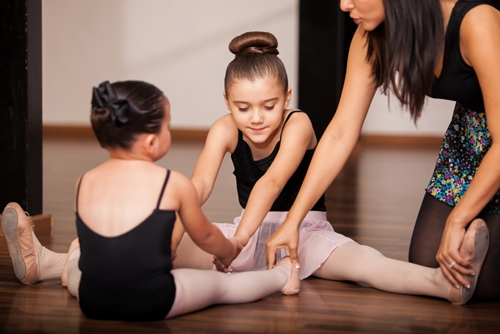How many times have you had a dancer cramp up during class and not be able to continue? Probably too many to count. When students, especially beginners, are pushing themselves a little too hard, their bodies will probably fight back. Muscle cramps, especially those in the feet and back, are painful and sometimes crippling to dancers, so it’s important that you know how to treat muscle cramps for your dancers, relax the muscle during class and prevent the problem in the future.
Quick Fixes for Tight Muscles
When one of your students gets a cramp during class, the first thing you should do is to get him or her something to drink. Individuals should drink 64 ounces of water every day – that’s approximately four bottles of water – and dancers should consume even more. DanceTeacher magazine explained that when students get dehydrated, their bodies aren’t able to keep with the pace of class, leading to cramps. Make sure that your dancers are taking regular water breaks throughout rehearsal to prevent these issues.
The next thing your dancer needs to do is relax the muscle that’s cramped. Have the student take deep breaths and massage the muscle with a foam roller.
“It really helps to breathe anytime you’re dancing and you feel like you’re getting exhausted,” Megan Richardson, a certified athletic trainer at the Harkness Center for Dance Injuries, told DanceTeacher magazine. “It calms [the] nervous system so those overstimulated muscles relax.”
Once the dancer can walk, have her slowly take a lap around the studio. It might seem counterintuitive, but walking will help leg muscles to stretch out from their contracted position. For foot cramps, encourage your dancer to do a few ankle circles and toe curls to help those muscles relax.
Target Problem Areas with Stretching
To prevent muscle cramps or spasms in the future, show your dancers some preventive stretches and encourage them to designate a little extra time to warm up and cool down. Before class, dynamic stretches will be the most beneficial, as they get the blood pumping with low-intensity movement.
“Even walking or biking to class is an ideal way to get the blood moving and raise the body’s temperature,” Jennifer Gamboa, president of the rehabilitation facility Body Dynamics, told Dance magazine. “Simply put, the body needs movement to get ready to dance.”
Gamboa recommended having your students try leg brushes, arm circles, trunk rotations and traveling lunges to get their bodies warmed up before class. Once the rehearsal is finished, that’s the time to focus on static stretching, where you work on lengthening certain muscles.
Banish Cramps with a Preventative Diet
Your dancers’ diets are equally as important in preventing muscle cramps. Encourage your students to eat foods rich in electrolytes, which will help to replace nutrients lost through sweat. Bananas, kiwi and yogurt are all packed with potassium, which can help to ward off cramps. Some other good choices are whole grains, apricots and avocados for magnesium, nuts and vegetable juice for sodium, and broccoli, milk and cheese for calcium.
“The best time to eat is 30 to 45 minutes after exercise, because that’s when the body is at its prime time to uptake all the nutrients,” Allison Wagner Eble, Cincinnati Ballet’s registered dietitian, told DanceTeacher magazine.
Sports drinks are a good way to replace electrolytes in a pinch, but healthy foods also provide other valuable nutrients that will contribute to overall wellness. Plus, sports drinks often contain high levels of added sugar, which can be harmful to the body when consumed in excess.




